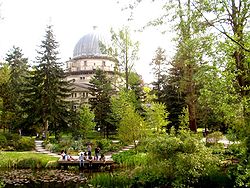
Jardin botanique de l'Université de Strasbourg
Encyclopedia


Botanical garden
A botanical garden The terms botanic and botanical, and garden or gardens are used more-or-less interchangeably, although the word botanic is generally reserved for the earlier, more traditional gardens. is a well-tended area displaying a wide range of plants labelled with their botanical names...
and arboretum
Arboretum
An arboretum in a narrow sense is a collection of trees only. Related collections include a fruticetum , and a viticetum, a collection of vines. More commonly, today, an arboretum is a botanical garden containing living collections of woody plants intended at least partly for scientific study...
located at 28 rue Goethe, Strasbourg
Strasbourg
Strasbourg is the capital and principal city of the Alsace region in eastern France and is the official seat of the European Parliament. Located close to the border with Germany, it is the capital of the Bas-Rhin département. The city and the region of Alsace are historically German-speaking,...
, Bas-Rhin
Bas-Rhin
Bas-Rhin is a department of France. The name means "Lower Rhine". It is the more populous and densely populated of the two departments of the Alsace region, with 1,079,013 inhabitants in 2006.- History :...
, Alsace
Alsace
Alsace is the fifth-smallest of the 27 regions of France in land area , and the smallest in metropolitan France. It is also the seventh-most densely populated region in France and third most densely populated region in metropolitan France, with ca. 220 inhabitants per km²...
, France
France
The French Republic , The French Republic , The French Republic , (commonly known as France , is a unitary semi-presidential republic in Western Europe with several overseas territories and islands located on other continents and in the Indian, Pacific, and Atlantic oceans. Metropolitan France...
. It is open daily without charge.
The garden was established in 1619 for the city's Académie (which in 1621 became the University) and is thus the second oldest botanical garden in France after that of Montpellier
Montpellier
-Neighbourhoods:Since 2001, Montpellier has been divided into seven official neighbourhoods, themselves divided into sub-neighbourhoods. Each of them possesses a neighbourhood council....
. It was created on the cemetery grounds of the convent Saint-Nicolas-aux-Ondes. This first site was then known as the Krutenau (plain of cabbage), and is now the Place de l'Ecole des Arts Decoratifs. This early garden was kept by the faculty of medicine. Its first inventory, published in 1670 by Marcus Mappus, listed some 1600 species. The entire university was suppressed in 1792 after the French Revolution
French Revolution
The French Revolution , sometimes distinguished as the 'Great French Revolution' , was a period of radical social and political upheaval in France and Europe. The absolute monarchy that had ruled France for centuries collapsed in three years...
, but the garden's director, Jean Hermann
Johann Hermann
Johann, or Jean, Hermann was a French physician and naturalist. He was professor of medicine at the University of Strasbourg. He was the author of Tabula affinitatum animalium and Observationes zoologicae quibus novae complures, published posthumously in 1804...
, managed to preserve not just the garden itself but also the statues of the Strasbourg Cathedral
Strasbourg Cathedral
Strasbourg Cathedral or the Cathedral of Our Lady of Strasbourg is a Roman Catholic cathedral in Strasbourg, France. Although considerable parts of it are still in Romanesque architecture, it is widely consideredSusan Bernstein: , The Johns Hopkins University Press to be among the finest...
, which he buried within the garden.
In 1870 with the German army besieging Strasbourg, the garden again became an informal cemetery, and in 1871 the territory became a part of Germany. In 1880 Wilhelm II, German Emperor, began reconstruction of the Université Impériale as a scientific and cultural showcase, creating eight new institutes, the observatory and zoological museum, and today's botanical garden located on a new site, formerly the old city walls, under the leadership of botanist Heinrich Anton de Bary. The garden and its magnificent greenhouses were inaugurated in 1884.
In 1919 the garden reverted to French territory after World War I
World War I
World War I , which was predominantly called the World War or the Great War from its occurrence until 1939, and the First World War or World War I thereafter, was a major war centred in Europe that began on 28 July 1914 and lasted until 11 November 1918...
. Most of its greenhouses were destroyed by hail in 1958, and only the Bary Greenhouse, a work by Hermann Eggert, the architect of the Palais du Rhin
Palais du Rhin
The Palais du Rhin , former Kaiserpalast , is a building situated in the German section of Strasbourg, dominating the Place de la République with its massive dome...
, was saved from demolition in 1963. Newer greenhouses were built in 1967.
Today the garden contains about 15,000 specimens representing more than 6,000 species of plants, and is operated by the Université Louis Pasteur. It consists of 9 plots surrounding the Institute of Botany: an arboretum
Arboretum
An arboretum in a narrow sense is a collection of trees only. Related collections include a fruticetum , and a viticetum, a collection of vines. More commonly, today, an arboretum is a botanical garden containing living collections of woody plants intended at least partly for scientific study...
, tropical greenhouse, cold greenhouse, the Bary Greenhouse, a greenhouse of grasses, a pond, the systematic garden, ecological plantings, and useful plants.
External links
- Pictures of the Jardin botanique on photo-alsace.com

